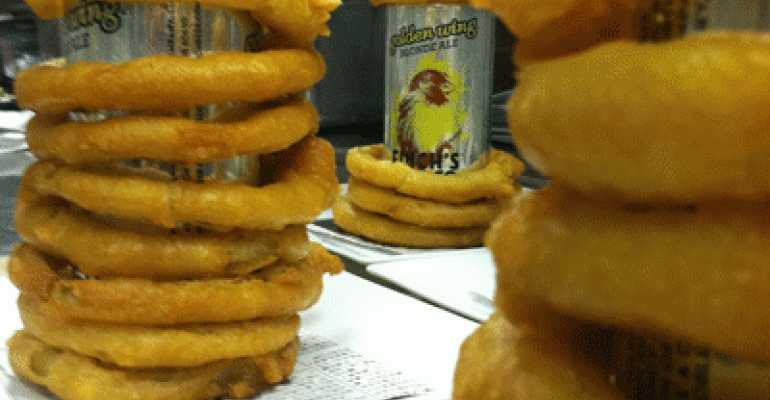The first Canned Beer Dinner at Tokio Pub in Schaumburg, Ill., gave guests a grip on two hot topics in today’s industry — craft beer in cans and locally produced beverages.
The four-course, $45-per-person event featured products from Chicago-area craft brewers like double IPA, or India pale ale, paired with Asian BBQ Pork Sandwiches, blonde ale with Tokio Pub Fish and Chips and stout with liquid-center chocolate cake. Adding to the novelty of the evening were beer-inspired plate presentations like a can-shaped parmesan tuile perched atop a green salad and beer-battered onion rings looped around an empty suds can.
“Initially, people were wowed that they each got their own can of beer,” said Jill Koval, general manager of the pub, which blends Asian and Latin-American culinary influences and is part of the Chicago-based Lettuce Entertain You Enterprises restaurant group. “And they really got to see how much we pride ourselves on food presentation. By the end of the night, everyone was pushing their tables together and having so much fun.”
The pub’s beer list is made up exclusively of cans and beers on draft. All told, there are 10 standard 12-ounce cans ranging from mainstream U.S. lagers to Mexican and Japanese imports and local craft choices. Add to that seven “big cans” ranging from a 14.9-ounce Irish stout to a jumbo 22-ounce Japanese reserve lager. One of the popular choices served at the dinner is a strongly hopped brew that is made just 20 minutes away from the pub in suburban Chicago, Koval noted.
Cans, once synonymous with mass-market and budget-priced brews, have become a trendy packaging choice for quality domestic and international beer brands in recent years. According to the Brewers Association in Boulder, Colo., more than 50 U.S. craft brewers are canning, and the number is growing. Proponents of cans say they preserve beer flavor better than bottles because they are more impervious to light and oxygen. Plus, they are more eco-friendly because they are lighter to ship and more readily recyclable than bottles.
“We talked to the local brewers and they all felt that the can was like having the keg in your hand,” said Koval. “We also liked how much better it is for the environment.” Furthermore, cans take up much less storage space in the restaurant than bottles would, Koval noted.
Nevertheless, there were some raised eyebrows among customers last spring, Koval said, when the pub debuted with its all-aluminum brew lineup.
“Some customers said, ‘What do you mean you don’t have any bottles?’ We said ‘Trust us. It’s okay.’ Now they really appreciate the beers we bring in for them.”
Craft beers in cans also make a beer dinner distinctive by showcasing the colorful graphics that are typically splashed across them.
“We could have had two people share a can between them, but it’s very neat to be able to see the labels, so we made sure that each guest had their own beer in front of them,” Koval said.




